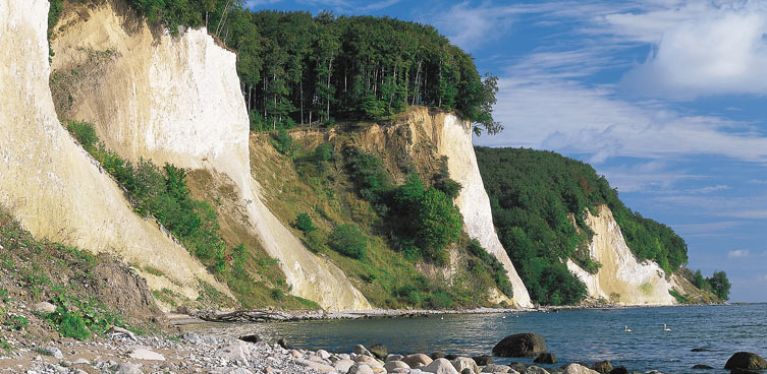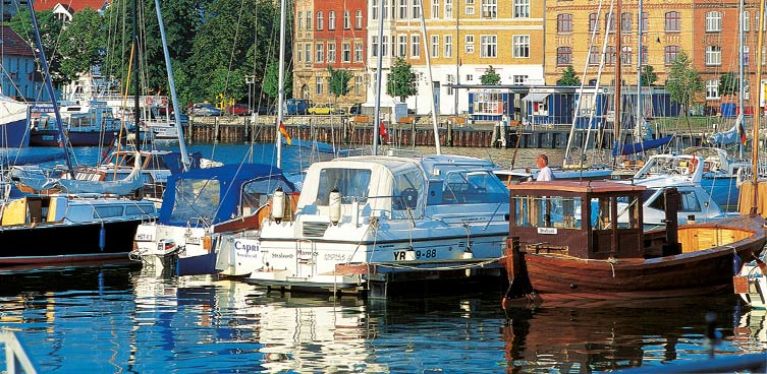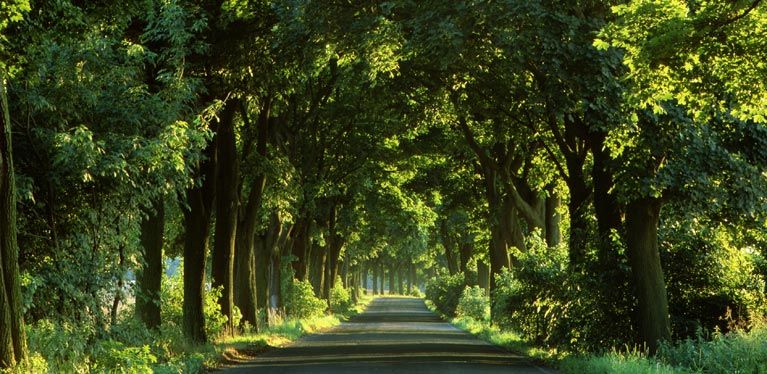German Avenue Route
German Avenue Route
From the Baltic to Dessau.
Picture yourself on a sunny weekend with the top down, cruising iconic tree-lined avenues, enchanted by the flashing sun filtered through the leaves – next stop Nirvana? The German Avenue Route gives you that intense “back to nature” feeling of oneness with the road and the world.At 3,000 kilometres, this mother of road trips is Germany’s longest, from the Baltic island of Rügen to Lake Constance. Eighty percent of all avenues are located in the north east of Germany, so the trip through Mecklenburg-Vorpommern, Brandenburg und Sachsen-Anhalt is an Eldorado for avenue fans. Many are small, quiet country roads lined with ancient trees; an exhilarating driving experience that memories are made of. As if that wasn’t enough, you will pass four UNESCO Heritage Sites on the 450-kilometre trip: Nationalpark Jasmund on Rügen, the Hanseatic city of Stralsund, the Bauhaus in Dessau and the Dessau-Wörlitz Gartenreich.
It goes without saying, but any wine stops detailed on this page are for the benefit of hire car passengers ... designated drivers must confine themselves to drinking in the scenery. Book a hire car now and explore Central Europe
Rügen – where nature and culture meet
Your road trip starts on this popular holiday island in the Baltic. Nationalpark Jasmund is a jewel of nature with its iconic chalk cliffs and the centuries-old beech forests. Take the shuttle from the central parking area in Hagen to the visitor centre and explore the park, which is the first UNESCO Heritage Site on your route. Then it’s back to the car to take L303 and L29 to cruise along the tree-lined avenues to the resort town of Putbus, take a stroll and admire the classicistic style of architecture and the extensive parks.Check out the so-called Putbus Circus, set up as a circular park with magnificent houses on all sides and only a stone’s throw from the Schlosspark with its unique giant sequoias and tulip poplars. Although the palace itself was dynamited in 1964, the Orangery remains a nostalgic memory of former glory and now a popular venue for exhibitions and weddings.


Stralsund – “Venice of the North”
Leaving Rügen and back on the mainland, your next stage is a 30-kilometre hop over to the venerable Hanseatic city of Stralsund. This UNESCO Heritage Site is so impressive that passing by without stopping would be a major faux pas. You’d miss the sights and sounds that make Stralsund so unique and unforgettable, like the historic old town with its medieval brickwork, the stepped Gothic gables, the famous Lotsenhaus [pilot’s house] and the harbour grain store, as well as the award-winning maritime museum.Stralsund’s stellar location directly on the Baltic and its wide network of canals have earned it the nickname “Venice of the North”. It’s quite possible that the relaxed north German approach to life, together with their open-minded, worldly attitude have got something to do with this title as well.
Waren and Schloss Klink – Lake Müritz's lake district
“Where forest and water meet” is a recurring theme throughout the entire trip along the Avenue Route. Next up is a magnificent section of the L20 through Malchin to the lake district in and around Lake Müritz. The leaves in the trees above ripple in the breeze and seem to merge with the rippling waters of the lake as you pass. Make a pit stop in the spa town of Waren, directly on the lake and refuel with some fresh fish delicacies in one of the many restaurants on the harbour.If you’re curious about the local fish and the unique flora and fauna found in the Mecklenburg Seenlandschaft [lake district], head straight for the Müritzeum Museum, also known as the House of 1,000 Lakes. A few kilometres from Waren lies Schloss Klink, now an exclusive hotel located right on the lake. A visit to this gourmet haven will remain etched indelibly on your mind.


Rheinsberg – Palace on the lake
Take the B192 for a trip around Lake Müritz, dubbed the “little sea” by the Slavs; the road passes several beautiful nature parks and protected wetlands. Next stop is Rheinsberg, a vibrant cultural hotspot. Rheinsberg Palace with its picture postcard location on Lake Grienerick is open to visitors all year round.Don’t miss the enchanting palace gardens laid out in the classicist style popular in the 18th century. None other than Frederick the Great spent his younger years in Rheinsberg before ascending to the Prussian throne in Berlin. Frederick restored the palace in his signature architectural style, the so-called Frederician Rococo, the literary giant Theodor Fontane and other writers later became ardent admirers.
Today, the left wing of the Palace houses the Kurt Tucholsky Literature Museum, commemorating the author who lived in the palace for some time and immortalised it in his writing.
Travel tip: Ruppin forest and lake district
Rheinsberg is right in the middle of the Ruppin forest and lake district and if you follow the B122, it will bring you to Neuruppin, Fontane’s birthplace. Revitalise with a pit stop at the exclusive Fontane thermal baths, and take in the gorgeous scenery from a different angle with a boat trip on the lake.Suitably energised, take the L167 and L19 to Kremmen; feel the romantic vibe of the tree-lined avenues along the way. Take it easy under the leafy canopy as you pass Berlin to the west; take the B273 to Nauen and the L91, through idyllic scenery dotted with small villages, almost like a dream where time has stood still.
Continue on the L912 and L981 through forests and past lakes until arriving safely in Brandenburg an der Havel.


Brandenburg – the beating heart of the Havel region
Brandenburg an der Havel was host city for the 2015 German Garden Show and Exhibition but as much as you will marvel at the city’s unparalleled landscaping and gardening skills, don’t miss the fabulous architectural sights.Must-see highlights include the island cathedral of St. Peter and Paul which is well-known throughout the region, the Museum of Archaeology in the Pauli Monastery, the Brandenburg Industrial Museum (aptly located in a former steel mill) and Gollwitz Castle - a regular venue for cultural events.
Dessau – where function meets horticulture
Continue south on quiet country roads that take you through the Naturpark Fläming, a sprawling wooded area. Cross the mighty River Elbe near Roßlau and head straight to Dessau. This city in the Sachsen-Anhalt region has a stellar reputation for two things: architecture and horticulture.Dessau is the proud home of two UNESCO Heritage Sites and they couldn’t be more different from each other: the Bauhaus School of art and design, known in the 20s and 30s for its harmony of form and function, was led by architecture greats Walter Gropius or Ludwig Mies van der Rohe and ignited a revolution in architecture and design.
Opulent or verdant are the words that spring to mind in the Dessau-Wörlitz Gartenreich [garden kingdom], where the palaces and country parks are a gorgeous collage of styles, from the antiquities, to classicism, baroque and rococo.
